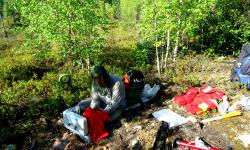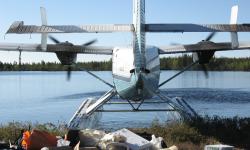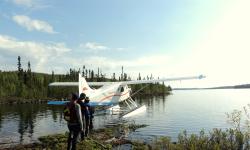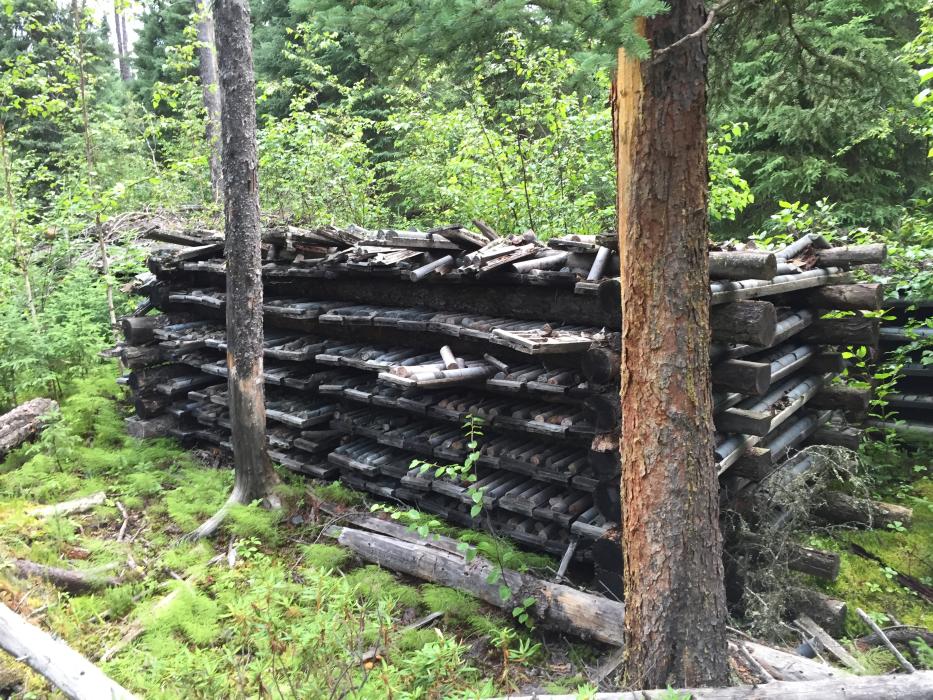
Eagle Plains and Xcite Provide Update on Black Bay Uranium Project
Saskatchewan | June 5, 2024Cranbrook, B.C., June 05, 2024: Eagle Plains Resources Ltd. (“EPL”:TSX-V, or “Eagle Plains”) and Xcite Resources Inc. (TSX-V:XRI) (“XRI or Xcite”), have received the results from a data compilation on the Black Bay uranium project, located 10.9 km SE of Uranium City, Saskatchewan. The Black Bay tenures cover the past-producing Black Bay Mine as well as five additional uranium occurrences, and is one of six 100%-owned Eagle Plains uranium properties currently under option to Xcite (see EPL/XRI news release Dec 14, 2023). The compilation and interpretation of available data will lead to recommendations for 2024 fieldwork.
Black Bay Data Compilation Highlights
- Five documented uranium and two gold Saskatchewan Mineral Deposit Index (SMDI) occurrences,
- Tenures overlie the past-producing Black Bay Uranium Mine,
- Trench samples include 6.51% U3O8, 3.78% U3O8 and 3.62% U3O8 over 0.3m,
- Drill results include 0.66% U3O8 over 0.3m,
- Property hosts Beaverlodge-style basement-hosted uranium mineralization.
See Black Bay Compilation map here
About the Black Bay Project
The 1114ha project overlies 7 Saskatchewan Mineral Deposit Index (“SMDI”) occurrences including the past-producing Black Bay Uranium Mine (SMDI 1296).
The Black Bay property geology is complex, and includes quartzites, metavolcanics, metasediments, gabbros and granitic intrusions. Uranium mineralization occurs near lithological contacts and faults, is typically present as pitchblende, and is often associated with sulphides. Vein-hosted gold mineralization is also present on the property.
Pitchblende mineralization at the Black Bay Mine occurs in drag folds along the contact zone between quartzites and gabbros, and is typically associated with hematite and graphite. Several small ore shoots are developed adjacent to the contact for a strike length of 152.4 m and a down-dip distance of 731.5 m. The mineralization has a strong structural component which defines three main ore shoots, the A, B, and C Zones. The A Zone extends a length of 13.7 m and width of 0.9 m with an average grade of 0.47% U3O8. Zone B extends 22.9 m over a width of 1.5 m with an average grade of 0.72% U3O8 and Zone C extends 6.1 m over a 4.6 m with an average grade of 0.91% U3O8 (AF 74N07-0025).
Approximately 0.6 km west-northwest of the Black Bay portal is the Bluegrass Uranium Zone A showing (SMDI 1295), consisting of a brecciated zone in the quartzite adjacent to the contact with the gabbro- hosting pitchblende associated with graphite and sulphides. West of the A Zone are the B and C (Powder) Zone occurrences, along the same graphitic contact. An extensive trenching and sampling program in 1955 returned values ranging from trace amounts up to 6.51% U3O8 over 30cm from the B Zone West (74N09-0111). Other B Zone samples had average grades of 3.78% U3O8 over 0.3 m by 0.3 m (sample 710) and 3.62% U3O8 over 0.3 m by 0.6 m (sample 528). 33 diamond drill holes were completed along the Blue Grass trend, totalling 1659 m. Sample 514 from hole A-19 at the b Zone extension, assayed 0.66% U3O8 over 0.3 m (from 54.25 m to 54.55 m) (74N09-0111).
In the western portion of the Black Bay tenure are the Brunston Mining Uranium Zones No. 1 (SMDI 1363) and No. 3 (SMDI 1364). Zone No. 1 consists of scattered radioactive fractures that occur in arkose just above the Martin Formation unconformity. Diamond drilling was completed over the showing and the best assay returned was 0.21% U3O8 over 0.6 m (74N10-0138). Zone No. 3 consists of a brecciated area that hosts pitchblende within a unit of reddened quartzite containing pitchblende, sulphides and quartz. Trench samples taken at the showing returned from 0.06% to 6.25% U3O8 (SMDI 1364).
The Bearcat Showings (SMDI 1258) are located in the eastern part of the property. At the Bearcat No. 1 Zone or the Bearcat Uranium Occurrence schist-hosted uranium mineralization is exposed in a series of trenches. Grab sample U90-107 returned 0.47% U3O8 (74N09-0286). Uranium mineralization at the Bearcat No. 2 Zone is associated with sulphides, graphite and gold and occurs along a contact between a quartzite and a chlorite schist. The area has been explored with trenching and limited shallow diamond drilling. Historical results include grab samples which returned from trace values up to 0.52% U3O8, 0.34% U3O8 and 0.31% U3O8. Analytical results from hole BC-4 drilled at Bearcat No. 2 zone returned 0.22% U3O8 and 0.44% Cu from 54.5-55.0 m. Chip samples at the Bearcat No. 3 Zone over widths of 0.10-0.20 m returned up to 2.285% U3O8, 13.9 ppm Au, 80 ppb Pt and 15 ppb Pd (74N09-0286).
Black Bay History
The first period of activity at Black Bay was from the early 1950s until 1960. From 1953-1960 Black Bay Uranium Ltd. discovered and developed the Black Bay Uranium Mine, which produced approximately 1375 tons of material with a grade of 0.17% U3O8 that was shipped to the Lorado custom mill for processing. Between 1953 and 1956, Brunston Mining Company Ltd. explored their No. 1 and No.3 showings (SMDI 1363 & 1364) with a ground Geiger survey, trenching and 29 diamond drill holes totalling 1567.93 m on the Herb and Peg claims, parts of which overlap the current tenure in southwest.
In 1955, Blue Grass Uranium Mines Ltd. discovered the Bluegrass Uranium Zone (SMDI 1295), located west of the Black Bay uranium mine. Blue Grass conducted geological mapping, Geiger prospecting, trenching, stripping, and completed 1659m of diamond drilling in 33 holes. (74N09-0111). Other companies active in the area during this time included Canadian Astoria Minerals Ltd., Reward Uranium Ltd., Ebor Uranium Mines Ltd., and Scintilore Mines Ltd., which discovered the Bearcat Lake mineralization (SMDI 1258).
In 1967, Bearcat Uranium Ltd. explored the Bearcat Lake area while Majestic Mines Ltd. worked the Brunston Mining and Blue Grass areas. Bearcat carried out an airborne scintillometer survey which identified nine radioactive anomalies. Majestic completed 15 diamond drill holes (831m) across the Blue Grass B Zone and Powder Zone showings.
Saskatchewan Mining and Development Corporation (SMDC) was active in the Black Bay area in 1979 – 80, conducting work in the Bearcat showing area (74N09-0286). A ground scintillometer survey and a 92.37-line km airborne VLF-EM survey were completed, revealing numerous strong conductors along east-west oriented linear belts across the Bearcat-Mackintosh areas. This was followed up with trenching and a 16-hole, 1159m diamond drilling program. SMDC returned to the Bearcat area in 1987-88, completing re-sampling of select drill holes from 1979-80.
The next exploration in the Black Bay area occurred in 1997 when Greater Lenora Resources Corporation conducted an airborne DIGHEM-V geophysical survey over the central part of the current black Bay tenures. Several EM anomalies typical of massive sulphide responses were reported (74N-0007).
The last recorded work on the current tenures was by Dubnick in 2010 who located SMDI 5629 with prospecting.
Management of Eagle Plains and Xcite are encouraged by the tenor of mineralization displayed in trenches and historical drilling at Black Bay and believe there is significant potential for additional uranium mineralization to be discovered both along strike and to depth within known mineralized areas. Interpretation of compiled data is underway and will be instrumental in forming recommendations for 2024 fieldwork.
Rock grab samples are selective samples by nature and as such are not necessarily representative of the mineralization hosted across the property. The above results were taken directly from the SMDI descriptions and assessment reports (AF) filed with the Saskatchewan government. Management cautions that historical results were collected and reported by past operators and have not been verified nor confirmed by a Qualified Person, but form a basis for ongoing work on the subject properties.
About the Beaverlodge Uranium District
See Beaverlodge Uranium Projects map here
The Beaver River, Black Bay, Don Lake, Gulch, Lorado, and Smitty projects are located in the Beaverlodge District near Uranium City in the Lake Athabasca region of Saskatchewan. Occurrences of uranium mineralization are abundant in the Uranium City area and have been explored and documented since the 1940s. The Beaverlodge camp was the first uranium producer in Canada, with historic production of approximately 70.25 million pounds of U3O8 completed between 1950-1982, with ore grades averaging 0.23% U3O8. The two largest producers were the Eldorado Beaverlodge (Ace-Fay-Verna) mine and the Gunnar uranium mine. The Beaverlodge area has seen limited uranium-focused exploration since the early 1990’s.
Eagle Plains’ management cautions that past results or discoveries on proximate land are not necessarily indicative of the results that may be achieved on the subject properties.
Beaverlodge-style uranium deposits host structurally-controlled, high-grade mineralization in veins and breccia-fills within basement rocks. Mineralization often occurs at geological contacts and consists of structures filled with hematite, chlorite and graphite associated with pitchblende.
Uranium City Option Agreements
Under the terms of the agreements, Xcite may earn an 80% interest in each of the Beaver River, Black Bay, Don Lake, Gulch, Lorado, and Smitty projects by completing CDN$3,200,000 in exploration expenditures, issuing 750,000 common shares of Xcite and making cash payments to Eagle Plains of CDN$55,000 over four years, for an aggregate of CDN$19,200,000 in exploration expenditures, 4,500,000 shares and $330,000 in cash to Eagle Plains. Upon Xcite fulfilling the terms of any or all of the earn-in agreements, an 80/20 joint venture will be formed, with Eagle Plains retaining a carried interest in all expenditures until delivery by Xcite or its assigns of a bankable feasibility study. During the option earn-in period, XRI will be appointed as operator, and EPL will manage the exploration programs under the direction of a joint technical committee. The projects are owned 100% by EPL, which will retain an underlying 2% NSR royalty on the each of the properties.
Eagle Plains currently holds a 100% interest in 18 individual projects comprising a total of 40,050 ha of mineral dispositions in Saskatchewan covering both basement and unconformity hosted uranium targets. The projects range from early-stage grassroots to drill ready and are distributed throughout the prospective Athabasca Basin including the Patterson Lake South (PLS), Beaverlodge, and Dufferin-Centennial camps.
See EPL Saskatchewan U project map here
Qualified Person
Technical information in this News Release has been reviewed and approved by C.C. Downie, P.Geo., a director and officer of Eagle Plains, hereby identified as the “Qualified Person” under N.I. 43-101.
About Eagle Plains Resources
Based in Cranbrook, B.C., Eagle Plains is a well-funded, prolific project generator that continues to conduct research, acquire and explore mineral projects throughout western Canada, with a focus on critical metals integral to an increasingly electrified, decarbonized economy.
The Company was formed in 1992 and is the ninth-oldest listed issuer on the TSX-V (and one of only three that has not seen a roll-back or restructuring of its shares). Eagle Plains has continued to deliver shareholder value over the years and through numerous spin outs has transferred over $100,000,000 in value directly to its shareholders, with Copper Canyon Resources and Taiga Gold Corp. being notable examples. Eagle Plains latest spinout; Eagle Royalties Ltd. (CSE:“ER”) was listed on May 24, 2023, and holds a diverse portfolio of royalty assets throughout western Canada.
Eagle Plains’ core business is acquiring grassroots critical- and precious-metal exploration properties. The Company is committed to steadily enhancing shareholder value by advancing our diverse portfolio of projects toward discovery through collaborative partnerships and development of a highly experienced technical team.
Expenditures from 2010-2023 on Eagle Plains-related projects exceed $38M, the majority of which was funded by third-party partners. This exploration work resulted in approximately 50,000m of diamond-drilling and extensive ground-based exploration work facilitating the advancement of numerous projects at various stages of development.
Throughout the exploration process, our mission is to help maintain prosperous communities by exploring for and discovering resource opportunities while building lasting relationships through honest and respectful business practices.
On behalf of the Board of Directors of Eagle Plains
“C.C. (Chuck) Downie, P.Geo”
President and CEO
For further information on EPL, please contact Mike Labach at 1 866 HUNT ORE (486 8673)
Email: mgl@eagleplains.com or visit our website at https://www.eagleplains.com
Cautionary Note Regarding Forward-Looking Statements
Neither the TSX Venture Exchange nor its Regulation Services Provider (as that term is defined in the policies of the TSX Venture Exchange) accepts responsibility for the adequacy or accuracy of this release. This news release may contain forward-looking statements including but not limited to comments regarding the timing and content of upcoming work programs, geological interpretations, receipt of property titles, potential mineral recovery processes, etc. Forward-looking statements address future events and conditions and therefore, involve inherent risks and uncertainties. Actual results may differ materially from those currently anticipated in such statements.
Related Projects
Latest News Releases

Eagle Plains and Sun Summit Minerals Execute Option Agreement for the Theory Copper-Gold Project, British Columbia

Eagle Plains and Earthwise Minerals Execute Option Agreement for the Iron Range Gold Project, British Columbia
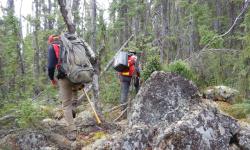
Eagle Plains and Partner Refined Energy Receive Permit for Drilling at Dufferin West Uranium Property, Saskatchewan
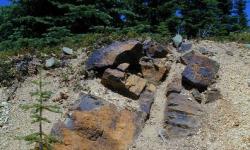
Eagle Plains Announces Letter of Intent with Earthwise Minerals for Option of the Iron Range Project, British Columbia
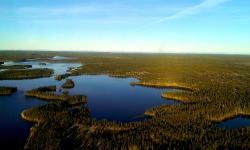
Eagle Plains Partner Xcite Resources Reports Results From Fieldwork at the Uranium City Area Projects, Saskatchewan

